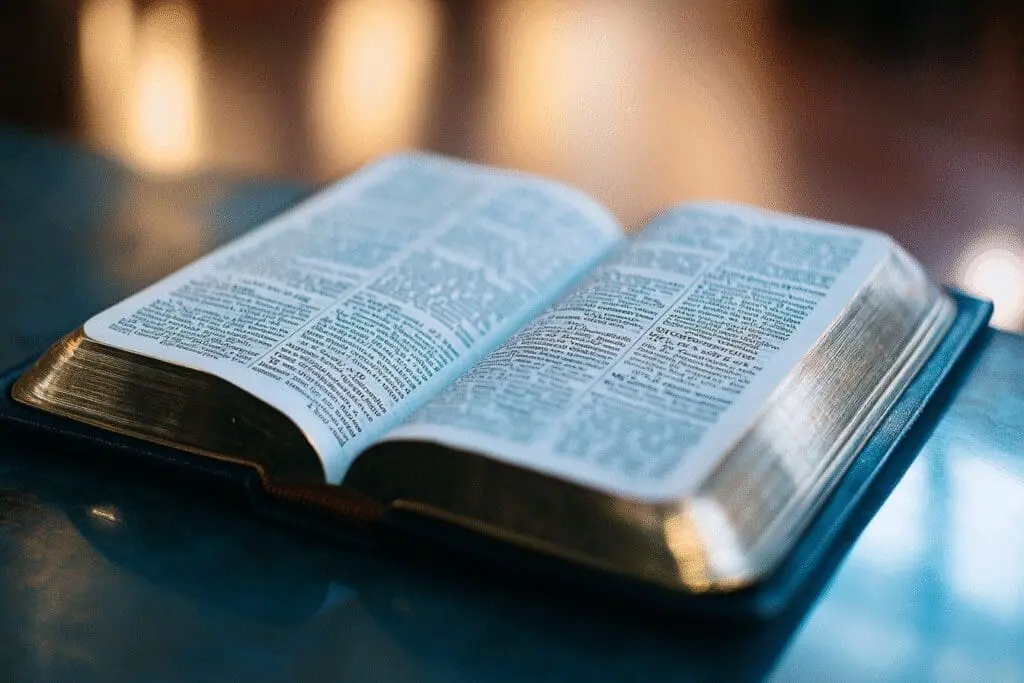I remember the first time I picked up a non-Catholic Bible. I was at a friend’s house, and we were looking up a verse together. I flipped to the Old Testament, expecting to find the book of Wisdom, but it just wasn’t there. For a moment, I was genuinely confused. “Where’s the rest of it?” I thought. That simple moment sparked a deep desire in me to understand why my Catholic Bible had more books. If you’ve ever asked, what extra books are in the Catholic Bible, you are not alone. It’s a fantastic question that gets to the heart of our faith’s rich history.
This isn’t just about a longer table of contents. It’s about a deeper, fuller collection of sacred stories that have been part of Christian Scripture since the very beginning. These books are filled with incredible accounts of faith, wisdom, and God’s unwavering love for His people. They aren’t just “extra”; they are an integral part of the story.
More in Bible Category
What Bible Version Is Best for Kids
Key Takeaways for a Quick Overview
For those who want the answer right away, here’s the summary. We’ll dive much deeper into each of these points, but this gives you a great starting place.
- Seven Full Books: Catholic Bibles include seven books in the Old Testament that are not in Protestant Bibles. These are Tobit, Judith, Wisdom, Sirach, Baruch, and 1 and 2 Maccabees.
- Two Expanded Books: Catholics also have longer versions of two existing books, Esther and Daniel.
- The Right Name: Catholics call these texts the “Deuterocanonical” books, which means “second canon.” This distinguishes them from the “Protocanonical” books (the first canon), which are the books found in both Catholic and Protestant Old Testaments.
- Historical Roots: These books were part of the Septuagint, a Greek translation of the Old Testament used by Jesus and the Apostles. The early Church accepted these books as inspired Scripture.
- Modern Differences: The decision by Protestant reformers in the 16th century to remove these books created the key difference we see in Bibles today.
So, Why Does the Catholic Bible Have More Books?
This is the big question, isn’t it? The answer takes us back centuries, long before the Bible was ever printed in English. The early Christian Church, the one built by the Apostles themselves, primarily used a Greek translation of the Old Testament called the Septuagint.
Think about the world during the time of Jesus. Many Jewish people, especially those living outside of Judea, spoke Greek, the common language of the day. The Septuagint was their Bible. It was the version quoted most often by the New Testament writers when they referenced the Old Testament. And importantly, the Septuagint included the seven Deuterocanonical books.
So, for the first Christians, these books were simply part of the Bible. There was no debate. They read them, prayed with them, and saw them as the inspired Word of God. This tradition continued for over a thousand years.
What Is the Septuagint and Why Is It So Important?
The Septuagint is one of the most significant translations in history. The name means “seventy,” coming from a tradition that seventy (or seventy-two) Jewish scholars translated the Hebrew Scriptures into Greek in the 3rd and 2nd centuries BC.
Its importance for us as Christians cannot be overstated.
- It was the Bible of the early Church.
- It’s the version the Apostles used when writing the Gospels and Epistles.
- It contained the Deuterocanonical books from the beginning.
When the early Church Fathers, leaders like St. Augustine, gathered at councils like the Council of Hippo (393 AD) and Carthage (397 AD), they formally affirmed the list of books that had been in use by the Church all along. This list included the Deuterocanonical books. They didn’t add books; they simply confirmed the canon of Scripture that was already the established tradition.
A Complete List of the Extra Books in the Catholic Bible
Let’s get to the heart of the matter. Here is the full list of the Deuterocanonical books and additions you’ll find in a Catholic Bible.
The Seven Deuterocanonical Books:
- Tobit
- Judith
- Wisdom (also called the Wisdom of Solomon)
- Sirach (also called Ecclesiasticus)
- Baruch
- 1 Maccabees
- 2 Maccabees
The Additions to Existing Books:
- Additions to Esther: The Greek version of Esther contains six additional sections, totaling 107 verses, that are not in the Hebrew version.
- Additions to Daniel: The Catholic version of Daniel includes three additional stories: The Prayer of Azariah and the Song of the Three Holy Children (found in Daniel 3), and the stories of Susanna and Bel and the Dragon (found at the end of the book).
What Are These Deuterocanonical Books About? A Closer Look
Knowing the names is one thing. But the real joy comes from understanding what these books contain. Each one offers a unique window into God’s relationship with His people. They are filled with lessons on faith, perseverance, and wisdom that speak to us just as powerfully today.
What is the Beautiful Story of Tobit?
The Book of Tobit is a wonderful and heartwarming story. It follows a righteous man named Tobit who, despite his faithfulness to God, suffers blindness and poverty. At the same time, a young woman named Sarah is tormented by a demon, and her seven husbands have all died on their wedding night.
In their despair, both pray to God for death. But God has a different plan. He sends the Archangel Raphael, in disguise as a human companion, to guide Tobit’s son, Tobias, on a journey. Along the way, Raphael helps Tobias find a wife (Sarah!), heal his father’s blindness, and drive away the demon.
It’s a beautiful story about God’s providence, the power of prayer, angelic help, and the importance of family and faithfulness. It shows that even when things seem hopeless, God is working behind the scenes for our good.
Who Was the Courageous Woman in the Book of Judith?
Judith’s story is one of incredible courage and faith. She is a devout widow whose town, Bethulia, is besieged by the massive Assyrian army led by the general Holofernes. The town’s leaders are ready to surrender, their faith completely gone.
But Judith is not. She scolds the leaders for testing God and then, trusting completely in the Lord, she devises a daring plan. She beautifies herself and goes into the enemy camp. She charms Holofernes and, when the moment is right, she beheads him in his own tent. Without their leader, the Assyrian army panics and is defeated.
Judith is a powerful example of how God can use one faithful person to save an entire nation. Her story teaches us that true strength comes not from armies or weapons, but from complete and total trust in God.
What Can We Learn from the Book of Wisdom?
The Book of Wisdom, often attributed to Solomon, is a stunning piece of poetry and theological reflection. It was written to encourage Jewish people living in a Greek culture to remain faithful to God.
The book powerfully contrasts the path of the righteous with the path of the wicked. It praises Wisdom, personifying her as a divine spirit who was with God at the beginning of creation. It teaches that true wisdom is found in a right relationship with God.
Furthermore, it offers some of the clearest teachings on the afterlife in the Old Testament. It beautifully states, “the souls of the righteous are in the hand of God, and no torment will ever touch them” (Wisdom 3:1). It’s a book of profound hope and encouragement.
Why is the Book of Sirach So Practical for Daily Life?
Sirach, also known as Ecclesiasticus (which means “Church Book”), is a goldmine of practical, everyday wisdom. It’s much like the Book of Proverbs. The author, a man named Jesus son of Sirach, collected and wrote down countless sayings about how to live a good and godly life.
The book covers an amazing range of topics:
- Friendship and family
- Humility and pride
- Honesty in business
- Controlling your tongue
- The proper way to worship God
Sirach connects this practical wisdom directly to faithfulness to God’s law. It teaches that the “fear of the Lord is the beginning of wisdom.” If you’re looking for timeless, godly advice on how to navigate the challenges of daily life, Sirach is an incredible resource.
What is the Message of Hope in the Book of Baruch?
Baruch was the scribe of the prophet Jeremiah. This book contains prayers, poems, and speeches attributed to him during the time of the Babylonian exile. It is a book written for people who are suffering and feel far from God.
The main themes are repentance and hope. The book calls the people to recognize their sinfulness that led to the exile, but it doesn’t leave them in despair. Instead, it offers a powerful message of God’s enduring mercy and His promise to restore His people. It contains a beautiful poem praising wisdom and ends with a message of soaring hope, promising that God will gather His scattered children home.
What Are the Historical Events in 1 Maccabees?
The book of 1 Maccabees is a thrilling historical account. It tells the story of the Maccabean revolt, a period when the Jewish people fought for their religious freedom against the oppressive Greek Seleucid Empire in the 2nd century BC. The king, Antiochus IV Epiphanes, had outlawed Jewish practices and desecrated the Temple in Jerusalem.
The book follows the heroic family of Mattathias and his five sons, especially Judas Maccabeus, who led a guerilla war against a superpower. It’s a story of incredible military feats and bravery. Most importantly, it’s about a people’s fight to remain faithful to God’s covenant against all odds. This book gives us the historical background for the Jewish festival of Hanukkah.
How is 2 Maccabees Different from the First?
While 1 Maccabees is a straightforward history, 2 Maccabees covers some of the same period but from a much more theological perspective. It isn’t trying to give a complete historical record; instead, it’s focused on teaching important lessons of faith.
This book contains powerful stories of martyrdom, most famously the story of the mother and her seven sons who refuse to break God’s law and are martyred one by one. Their testimony is a profound witness to their belief in the resurrection of the dead.
In fact, 2 Maccabees contains some of the clearest scriptural support for doctrines like:
- Praying for the dead (2 Maccabees 12:44-46)
- The resurrection of the body
- The intercession of saints
It’s a deeply moving book that shows the spiritual reasons behind the historical fight.
What About Those Additions to Esther and Daniel?
The “extra” parts of Esther and Daniel aren’t separate books but are chapters and verses woven into the existing texts. They add incredible depth and clarity to the stories.
The Additions to Esther: Where is God in This Story?
If you read the shorter, Hebrew version of Esther (the one in Protestant Bibles), you might notice something surprising: the name of God is never mentioned. The Catholic version, with its Greek additions, fixes this!
The additions include beautiful prayers by Mordecai and Esther, where they pour out their hearts to God. They make it explicitly clear that God’s hand is guiding the events of the story. These additions show that Esther’s and Mordecai’s courage comes directly from their deep faith and reliance on the Lord. It transforms the story from a clever court tale into a powerful drama of divine providence.
The Additions to Daniel: What Do They Add?
The longer version of Daniel in Catholic Bibles includes three powerful stories that have been cherished by Christians for centuries.
- The Prayer of Azariah and the Song of the Three Holy Children: This is inserted into the story of the fiery furnace in Daniel 3. As Shadrach, Meshach, and Abednego (named Azariah, Hananiah, and Mishael) walk unharmed in the fire, Azariah says a beautiful prayer of repentance. Then, all three sing a magnificent hymn of praise, calling on all of creation to bless the Lord.
- The Story of Susanna: This is a fantastic story of a righteous woman, Susanna, who is falsely accused of adultery by two wicked elders. She is sentenced to death, but the young boy Daniel, filled with the spirit of God, intervenes. He cleverly cross-examines the elders, exposes their lies, and saves Susanna’s life. It’s a wonderful tale of justice, purity, and God’s defense of the innocent.
- Bel and the Dragon: This section contains two stories where Daniel acts as a sort of detective to expose the foolishness of idolatry. In the first, he proves that the great statue of the god Bel doesn’t actually eat the food left for it; the pagan priests are sneaking in at night and taking it. In the second, he slays a great dragon that the people worship, proving it is a mortal creature and not a god.
Why Aren’t These Books in Protestant Bibles Then?
This is where history gets a little complicated. For 1,500 years, these books were part of the Christian Old Testament. The split happened during the Protestant Reformation in the 16th century.
Martin Luther and the other reformers adopted the principle of Sola Scriptura (Scripture alone). In doing so, they wanted to settle on a definitive list, or canon, of the Old Testament. They looked back to the Hebrew canon used by Jewish rabbis of their day, which did not include the Deuterocanonical books. Their reasoning was to return to the Hebraica veritas, or “Hebrew truth.”
So, Luther moved these books into a separate section between the Old and New Testaments, which he called the “Apocrypha,” meaning “hidden.” He wrote that they were “books that are not considered equal to the Holy Scriptures, but are useful and good to read.” Over time, as Bibles were printed more cheaply, this section was often omitted entirely to save costs, and eventually, most Protestant Bibles didn’t have them at all.
How Did the Catholic Church Respond?
In response to the Reformation, the Catholic Church convened the Council of Trent (1545-1563). Here, the bishops authoritatively reaffirmed what the Church had believed since the beginning: that the Deuterocanonical books are inspired, canonical Scripture. This was not a new decision. It was a formal definition of a long-held and ancient belief, confirming the canon of the Bible that had been established in the early Church councils. The process of forming the biblical canon is a fascinating piece of history, and you can explore the differences in more detail through academic resources like this guide from Saint Joseph’s University.
Finding Personal Value in the Deuterocanonical Books
This isn’t just an academic or historical debate. As a person of faith, I can tell you that these books are a spiritual treasure. They fill in crucial historical gaps and contain some of the most beautiful and inspiring passages in the entire Bible.
Reading about the Maccabean martyrs strengthens my own resolve to stand firm in my faith, no matter the cost. Reading the wisdom of Sirach gives me concrete advice for being a better husband, father, and friend. Praying with Tobit and seeing the work of the Archangel Raphael reminds me that God’s angels are always with us, protecting and guiding us.
These books enrich our understanding of the faith that Jesus and the Apostles inherited. They provide a deeper context for the New Testament and show us a God who is intimately involved in the lives of His people, in every struggle and every victory. If you haven’t read them, I wholeheartedly encourage you to open a Catholic Bible and discover this incredible part of our shared salvation story. You won’t just find “extra” books; you’ll find a fuller, richer, and more complete picture of God’s magnificent Word.
Frequently Asked Questions – What Extra Books Are in the Catholic Bible

Why did the Catholic Church include these extra books in their Bible?
The Catholic Church included these books because they appeared in the Septuagint, a Greek translation of Jewish scriptures used by early Christians, and were considered part of the Bible during the early church period, despite later Protestant revisions.
How do the deuterocanonical books differ in content from other biblical books?
The deuterocanonical books contain stories of faith and courage, wisdom literature, and historical accounts about key events in Jewish history, offering insights into lessons of faith, wisdom, and God’s help.
What are the additions to Esther and Daniel in the Catholic Bible?
The Catholic Bible includes six extra parts in Esther that add more detail and religious context, and three additional stories in Daniel—the Prayer of Azariah and the Song of the Three Holy Children, the story of Susanna, and Bel and a Dragon.
Why are some books called deuterocanonical instead of apocryphal?
The term deuterocanonical means ‘second canon,’ indicating that these books were added to the biblical canon later than the original list of accepted sacred texts, unlike apocryphal which often refers to disputed or non-canonical writings.
What are the deuterocanonical books in the Catholic Bible?
The deuterocanonical books are seven books included in the Catholic Old Testament that are not found in most other Bibles. They are Tobit, Judith, Wisdom of Solomon, Sirach, Baruch, 1 Maccabees, and 2 Maccabees.




